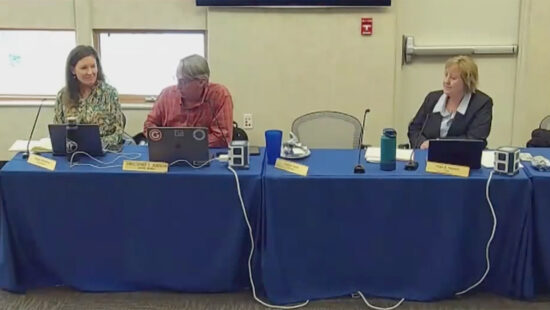Politics
Redistricting ruling: Utah judge picks plaintiffs’ congressional map, blocks Legislature’s

The Capitol and downtown Salt Lake City are pictured at dusk on Monday, Nov. 10, 2025. Photo: Spenser Heaps for Utah News Dispatch
Bumping all the way up against her deadline to decide what congressional boundaries will govern Utah’s 2026 elections, 3rd District Judge Dianna Gibson issued a key decision in the state’s court-ordered redistricting battle late Monday.
In her ruling, Gibson overwhelmingly sided with the plaintiffs in a lawsuit against the Utah Legislature, blocking the Republican-controlled Legislature’s map C from being used in the 2026 elections while instead approving one of the plaintiffs’ submitted alternatives, known as Map 1.
The Legislature’s map, she wrote, “fails in many ways to comply with Proposition 4,” a 2018 voter-approved law establishing an independent redistricting process and neutral map-drawing criteria.

“In sum, the record overwhelmingly supports the Court’s conclusion that Map C exhibits substantial pro-Republican bias,” the judge wrote in the 89-page ruling.
Her order came at about 11:40 p.m. Monday, minutes before midnight on the day the state’s top election officials said would be the latest possible date to set a congressional map in order to give county clerks enough time to prepare for candidate filings in January.
The judge’s selection gives Democratic candidates a good chance at one of Utah’s U.S. House seats in next year’s midterm elections, at a time when redistricting shuffles are playing out around the country and both major parties are pulling for an advantage.
Utah House and Senate Democratic lawmakers issued a prepared statement after midnight reacting to the ruling with “a deep sense of hope and relief.”
“This is a win for every Utahn,” the statement said. “We took an oath to serve the people of Utah, and fair representation is the truest measure of that promise.”
Gibson, in a ruling earlier this summer, voided Utah’s last congressional map that the Utah Legislature set in 2021. In that decision, the judge ruled their map was the result of an unconstitutional process after lawmakers that year undid a 2018 voter-approved ballot initiative known as Proposition 4, which established an independent redistricting commission and neutral map-drawing criteria meant to guard against gerrymandering.
To replace the 2021 map in time for the 2026 elections, Gibson ordered a “remedial” court process, giving the Utah Legislature and the plaintiffs suing state officials the opportunity to submit map proposals for her to pick from. She also restored Proposition 4 as law.
In a special session last month, the GOP-controlled Utah Legislature voted “under protest” to submit a map known as map C — one that Utah Republican Party leaders urged their members to support as the least damaging option.
Democrats argued that map C was the worst choice — especially when paired with a bill, SB1011, that the Legislature also voted to approve to require the state’s next congressional maps (including the one picked by Gibson) to pass three statistical tests meant to bar the maps from favoring one party over another.
Those tests (particularly one known as the partisan bias test) were problematic to use in a “lopsided” state like Utah, the plaintiffs argued, where active registered Republicans (916,236) outnumber Democrats (238,979) statewide by more than 677,000 voters. Republicans, however, argued in favor of codifying the three tests to clarify “vague” language in Proposition 4 and use their “discretion” to decide the “best available data and scientific methods” to use in evaluating maps, as Proposition 4 requires.
That prompted the plaintiffs in the redistricting lawsuit — which include the League of Women Voters of Utah, Mormon Women for Ethical Government, the Campaign Legal Center and a handful of Salt Lake County voters — to file another complaint in court.
They urged Gibson to block SB1011, alleging it “cherry picks” flawed statistical tests for states like Utah while accusing Utah lawmakers of again passing a law that “impaired” Proposition 4, therefore violating their right to alter and reform their government through a ballot initiative.
Gibson, in her ruling, agreed with plaintiffs’ arguments on SB1011 too — and preliminarily blocked it from taking effect.
“Map C does not abide by Proposition 4’s traditional redistricting criteria ‘to the greatest extent practicable,’” Gibson wrote. “And, based on the evidence presented, the Court finds that Map C was drawn with the purpose to favor Republicans — a conclusion that follows from even S.B. 1011’s metric for partisan intent — and it unduly favors Republicans and disfavors Democrats.”
By granting the preliminary injunction, SB1011 “is not the governing law for this remedial proceeding,” Gibson ruled.
Leading up to Monday night’s ruling, Gibson listened to more than 15 hours of testimony and fielded over 1,000 pages of evidence submitted by attorneys for the Legislature and the plaintiffs, each side citing competing redistricting experts in their arguments over why the judge should pick their preferred maps.
While alleging map C fell short of adhering to Proposition 4, the plaintiffs submitted two other map options for the judge to consider.
The plaintiffs’ Map 1, they said, came from a set of 10,000 maps “generated by a computer algorithm designed to comply with Proposition 4’s priority-ordered redistricting criteria without considering partisan data.” It splits only one city (Midvale) and “has a significant population overlap” with the Orange and Purple maps proposed by the Independent Redistricting Commission in 2018.
The plaintiffs also described their proposed Map 2 as a “least change” map based on the Legislature’s adopted map C but with “changes made to correct its failures to conform to Proposition 4’s requirements,” splitting only one city (Pleasant Grove).
From the other corner, legislative attorneys argued that lawmakers’ map C complied with Proposition 4’s ranked criteria, which prioritizes minimization of city and county splits first while also requiring prioritization of other redistricting principles like compactness, contiguity, respecting traditional neighborhoods and communities of interest, and following geographic features.
Map C split three cities (Millcreek, North Salt Lake and Pleasant Grove) into 11 pieces and three counties (Salt Lake, Utah and Weber counties) into seven pieces. The plaintiffs’ maps each split one city into two pieces (Map 1 split Midvale while Map 2 split Pleasant Grove) and three counties into six pieces (Salt Lake, Utah and Weber counties, in both maps).
Gibson, in her ruling Monday, sided with the plaintiffs’ arguments that the Legislature’s map did not comply with Proposition 4, was drawn with consideration of partisan political data, violated Proposition 4’s ban on partisan gerrymandering, and unduly favored the Republican Party over the Democratic Party.
While Utah’s Republican legislative leaders have said they don’t think the judge would have the constitutional authority to pick another map other than Map C, Gibson wrote in her decision that state and federal courts have supported court-ordered redistricting processes when legislatures fail to enact legal maps.
“This Court approaches this task somewhat reluctantly,” Gibson wrote. “But this is the remedial process recognized by the U.S. Supreme Court and by other state courts, agreed to by the parties in this case, and ordered by the Court. Based on the evidence — and after an evidentiary hearing — the Court found that Map C does not comply with Proposition 4’s requirements.”
To ensure “Utahns cast ballots under a congressional map that is equally apportioned under both federal and state constitutional requirements and that otherwise complies with Utah’s law on redistricting in Proposition 4,” Gibson said she must now choose a congressional map by the Nov. 10 deadline.
“The Court’s ruling on which congressional map will be adopted is not based on any policy,” she wrote. “Rather, it will be based on the law.”
What now?
The judge’s ruling gives more clarity — for now — when it comes to what Utah’s 2026 congressional boundaries will look like next year.
But there’s still plenty of uncertainty over the future of Utah’s redistricting process.
In continued angst over Proposition 4 — arguing the narrowly-passed law jeopardizes Utah’s “constitutional order” by removing the power of map-drawing from legislators — Utah Republican Party leaders and the political issues committee called Utahns for Representative Government are pursuing another ballot initiative to ask voters to repeal Proposition 4 during the 2026 elections.
For that ballot initiative, the group has been holding a series of public hearings across the state, including seven Monday night. To qualify the repeal question for the 2026 ballot, the group will need to collect at least 140,748 valid signatures from registered voters across Utah while meeting specific thresholds in at least 26 of Utah’s 29 Senate districts.
Initially, the Utah Republican Party had also said it would pursue a referendum on map C — the same map it had urged Utahns to support — but last week Utah GOP Chair Rob Axson told reporters party leaders decided against pursuing signatures for that effort, saying they now plan to put all of their effort behind the initiative to repeal Proposition 4.
“The only way to repeal a law that was passed through initiative, with Utah’s current understanding following court decisions, is through another initiative. The initiative has always been the primary focus of what we’re doing. Nothing has changed there,” Axson told ABC4.
Utah’s Republican leaders have also said they intend to continue to fight Gibson’s rulings in court by appealing the case to the Utah Supreme Court, and if necessary the U.S. Supreme Court.
But because the lieutenant governor’s office, which oversees the state’s elections, has said Nov. 10 would be the drop-dead deadline to determine the 2026 congressional map, it’s likely the map Gibson picked will indeed be used for next year’s election.
But for 2028? More court battles and legislative wrangling are likely to play out to determine the future of redistricting in Utah.
Additionally, Gibson is likely to continue to catch the ire of Utah’s Republican legislative leaders. During the Oct. 6 special session when the Legislature implemented map C, some Republican legislators indicated they would entertain the idea of pursuing articles of impeachment against Gibson if she didn’t pick their preferred map.

On the Senate floor that day, Sen. Dan McCay, R-Riverton, characterized Gibson’s court-ordered redistricting process as a “joke” and a “farce.” And Sen. Brady Brammer, R-Pleasant Grove, argued that the Utah Constitution says “the only way a map can be accepted is by approval by the Legislature.”
“It is our duty as a Legislature to approve a map, otherwise there is no other means by which a map may be used, even if parties ask for it,” Brammer said. “It would be a malfeasance in office — a malfeasance in office — for a court to attempt to accept a map that has not been approved by the Legislature, or for a lieutenant governor to certify and use a map that has not been approved by the Legislature.”
Under Utah law, elected officials and judges can only be impeached for “high crimes and misdemeanors or malfeasance in office.” Any impeachment proceedings would also be required to start in the House.
When pressed by reporters, House Speaker Mike Schultz, R-Hooper, would not say whether the House would be open to considering articles of impeachment against Gibson, saying, “I’m not going to get into what the House is going to do in a theoretical (situation).” However, he also said the Legislature will “do all we can to protect the power given to it in the Constitution.”
“Nowhere in the Constitution does it allow for a judge to be able to pick a map,” Schultz said at the time. “And we will adamantly defend that, to whatever means necessary.”




















